In 2020, with COVID restrictions in full force and not much work on my plate, I decided to leap into the world of trailer-sailing. Scouring through various trailer-sailing groups, I decided that a Siren 17, a popular Canadian 17′ trailer-sailer last manufactured in 1987, would be a good start. After years of sailing on mid-sized cruising sailboats, it took a bit of time to adjust to this much smaller craft, but I found the freedom of trailering the boat to explore new bodies of water quite compelling.
By the end of our first season of trailering and sailing, I felt that the Siren 17 lacked performance and thought we would enjoy a boat with a bit more cabin room. I stumbled upon the Flow 19, a stunning design built in La Rochelle, my hometown in France. In 2019, Voile Magazine, one of France’s leading sailing publications, named the Flow 19 the “Trailer-Sailer of the Year,” so I figured it had to be a good one.
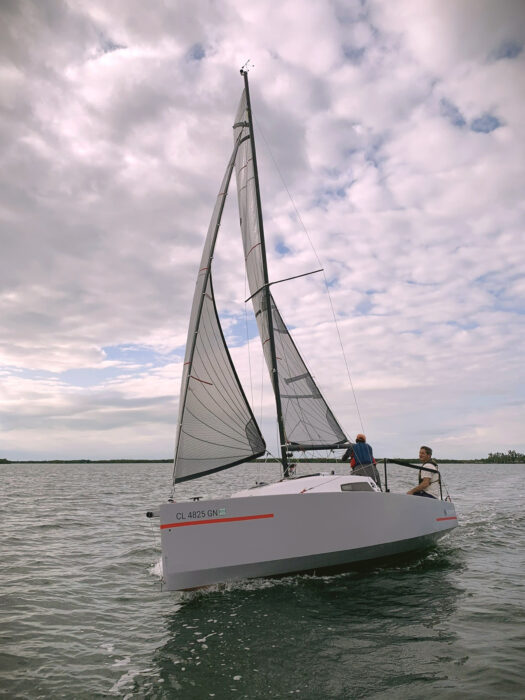 Photographs by Thierry Humeau
Photographs by Thierry HumeauThe Flow 19 has a generous sail area with a square-headed 151 sq ft mainsail and overlapping 91 sq ft genoa.
I soon reached out to Antoine Mainfray, the boat’s naval architect and owner of Atelier Interface, the shipyard where Flow 19s are built. Antoine had never exported a vessel to the U.S., but even with much left to figure out for the freight and import process, our mutual excitement quickly concluded in a firm order for Flow 19 hull #5. Construction was set to begin in the fall of 2020 with delivery planned for spring of 2021. With the pandemic dragging on and the supply chains in disarray, things got bogged down, but by late November 2021 our shiny Flow 19 finally showed up on its trailer at the port of Baltimore, Maryland.
The Flow 19 is a trailerable sport cruiser designed for performance sailing with ample storage and cabin room for comfortable cruising, built using the well-proven wood/epoxy stitch-and-glue method. Antoine, who is an expert in composite structures, also utilizes molds and vacuum-bagging to fabricate the boat’s critical components. The rudders, swing keel, and coach roof are built from a mix of carbon and ’glass materials, which provide great strength and durability. The shipyard prides itself in working toward a more sustainable model by integrating natural fibers and bio-sourced resins into the building process. For example, bamboo cloth is used in the coach roof as an alternative to carbon. The bamboo also provides a nice and natural finish inside.
The lines are pure and racy, and the first few times I showed up at a boat ramp, I quickly understood that the boat is a head-turner. With its flat bottom and fully retracted keel, the Flow 19 draws a mere 4″, which makes it particularly suited for beaching and gunkholing in shallow waters. With a dry weight of 992 lbs, it can be easily towed by a mid-sized car or small SUV.
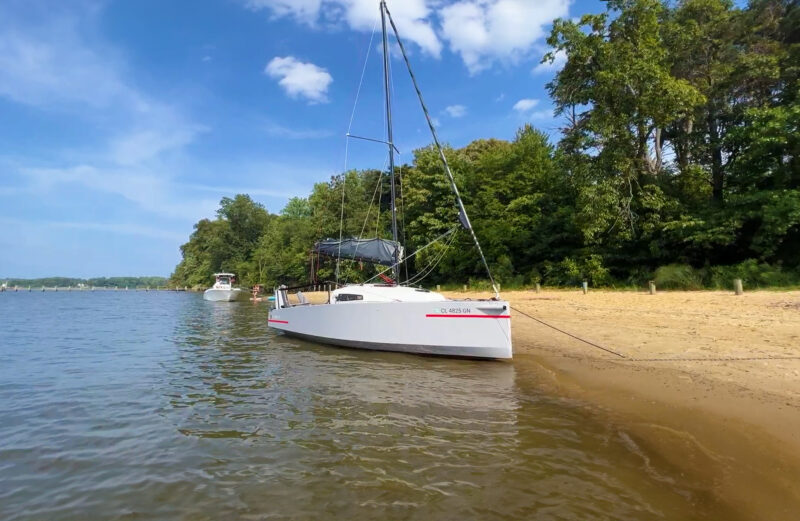
Thanks to its shallow draft and fully lifting centerboard, the Flow 19 can be anchored in shoal water, making it the ideal beach-cruiser.
When filled, the twin water ballast tanks add 264 lbs low in the hull. Located under the cabin settees, each tank is equipped with a large-sized Andersen automatic bailer. This ingenious and simple device, found on dinghies and other small craft, makes it easy to fill the tanks after launching the boat. Using the Venturi effect, the bailers can also be opened underway to drain the water, though it is much easier to empty the tanks by opening the bailers after pulling the boat out of the water. The Flow 19 can be sailed with empty ballast tanks in light winds (up to 17 knots with an experienced crew, according to Antoine), but since I do not notice a big difference in performance, I tend to keep the tanks full for convenience and safety.
The plumb bow and wide transom are reminiscent of the planing hulls seen on today’s larger offshore yachts. A generous cockpit accommodates up to four sailors and will keep them dry even in windy conditions and choppy waters. Two large watertight hatches give access to roomy lockers, perfect for storing fenders or other items such as a small inflatable tender. With the wide beam carried aft, the cabin and storage volume below the deck is quite remarkable for a boat of this size.
While the double berth in the bow is comfortable and wide enough at the shoulders for two, we decided on the extension option, which lengthens the berth by 16″ to 8′ 4″, providing storage space underneath for the porta-potti or other large items. The settee berths can accommodate small adults or kids. Thanks to the composite coach-roof structure, there is no need for a compression post in the cabin to support the mast and, with 51″ of headroom, there is enough comfort to play a card game or work on a laptop at the optional cockpit table. There are good-sized cubbies on each side, with additional storage under the settees and plenty of extra room aft under the cockpit for longer or voluminous objects. To maintain positive buoyancy, the space under the double berth and aft of the settee is filled with closed-cell foam.
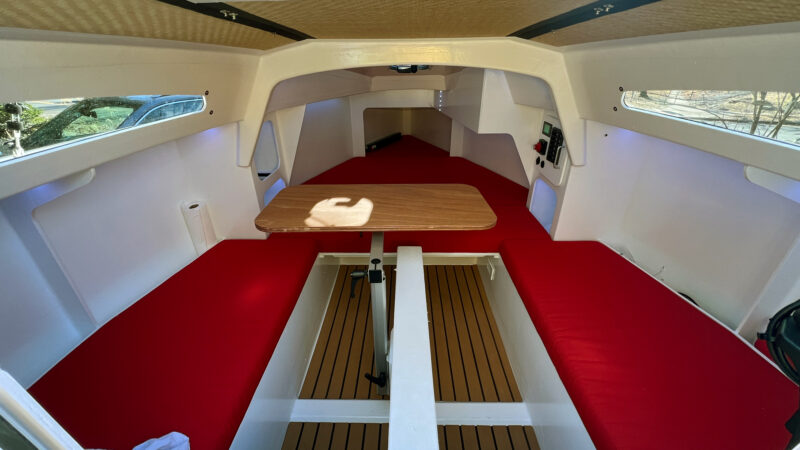
Despite her “sport“ credentials, down below the space is light, simple, and functional, with sleeping space for four people making the Flow 19 the ideal cruiser for coastal voyages. The coach roof is lined with bamboo cloth, used for its light weight and to complement the warmth and more natural appearance.
During the boat’s construction, I was in regular communication with Antoine and came to appreciate his focus on keeping things simple. Simplicity not only reduces the need for maintenance or parts but, especially on a small craft, helps keep the deck uncluttered and prevents the crew from getting snagged on hardware. The Flow 19’s running rigging is solely based on block-and-tackle, and even the fully retractable keel is controlled by a 9:1 pulley system built inside the keel trunk. The keel’s lifting and control lines are readily accessible in the cockpit. There are no mechanical winches or jib cars to control the jibsheets. Instead, cam cleats and a 2:1 purchase with small blocks at the clew provide enough force to sheet in the sail by hand. Barber-haulers and friction rings help move the jibsheets toward or away from the boat’s centerline. The mainsheet comes to a swivel cleat in the center of the cockpit and runs aft to a Dyneema bridle attached to the transom. All control lines are led aft.
A twin-rudder steering system that is easy to disassemble for trailering keeps the boat on track regardless of the angle of heel. Thanks to auto-release cleats, the rudder blades will automatically pop up when beaching the boat or hitting the ground in shallow waters. The mast is securely held in place by a set of shrouds, lower shrouds and a single spreader. The headstay doubles as a structural furler, which helps keep the foresail luff nice and tight. There is no traveler and no backstay. Often overlooked on smaller craft, there are four good-sized mooring cleats and an anchor locker, which Antoine considers vital on cruising boats. While the Flow 19 is a production boat, the shipyard welcomes customizations and offers quite a few options.
At the boat launch, the lightweight 20.5-lb aluminum-alloy mast is easy for one person to raise without the use of additional hardware. The mast crutch I made to support the mast when it is brought down for trailering is extendable to set the mast at a good angle while I lock it in its step. Once the mast is up, the jib or spinnaker halyard attached at the bow holds it vertical while securing the headstay. While the boat was being built, I sent Antoine a forestay tensioning lever from Johnson Marine. This wonderful device is the best friend of trailer-sailors. It puts the entire rig under tension in one step without the need to adjust the shrouds’ turnbuckles.
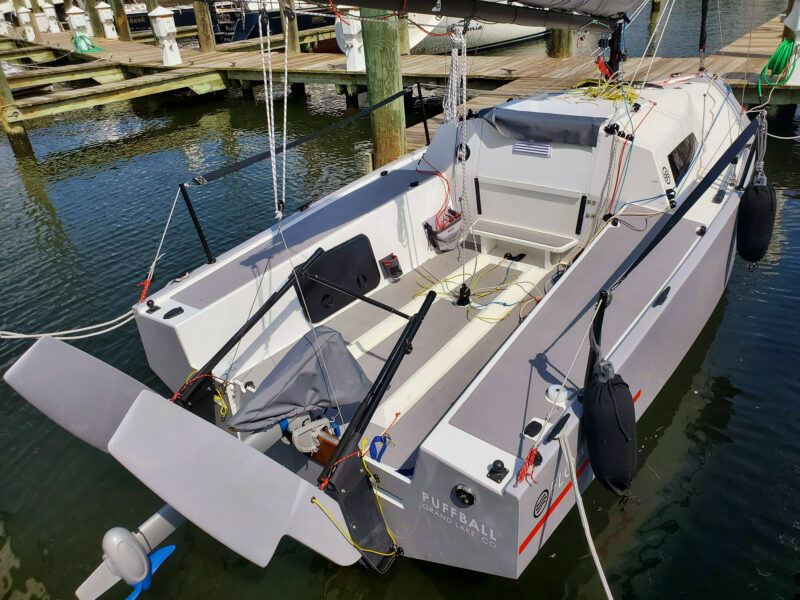
The twin rudders mean that the skipper can sit on either side to steer, while the lack of a bridging mainsheet traveler leaves the cockpit uncluttered and remarkably spacious for a 19′ boat.
Once the mast is up and the rig secured, it’s time to install the running rigging, boom, sails, and rudders, which are kept inside the boat during transportation. The Flow 19 is not as quick to rig as a cat- or gaff-rigged boat, but with practice it can be done in 30 minutes or less. Once the boat is ready for launch, it easily rolls off the trailer with a gentle push and, thanks to its shallow draft, a foot or two of water at the ramp is all that is needed.
We opted to go full electric for auxiliary power and purchased a 3-hp outboard from ePropulsion with two batteries (one is kept fully charged as a spare in the cabin for safety). Prior to making the purchase, I was concerned about the battery range, but with the power output kept at one-third throttle—in the 300- to 350-w range—a fully charged battery will move the boat at 3 knots for three or four hours, which is plenty of runtime for short trips.
The Flow 19 boat comes with a set of Dacron sails, but radial-cut performance laminate sails are also offered. As one can expect, the good-sized square-top mainsail and the 110 percent overlapping jib provide good thrust to the light but powerful hull. Hoisting or dousing the main is straightforward, but after a few times out I felt that adding a lazy bag sail cover would greatly help store the sail on the boom while on the hook or at a mooring. A lazy bag is also quite handy to keep everything together on the boom during transportation. Our boat is fitted with the optional carbon bowsprit, which can accommodate a variety of downwind sails. We chose a Code D, a hybrid cut between an asymmetrical spinnaker and a large genoa, that is easy to handle and provides a good deal of power when sailing off the wind.
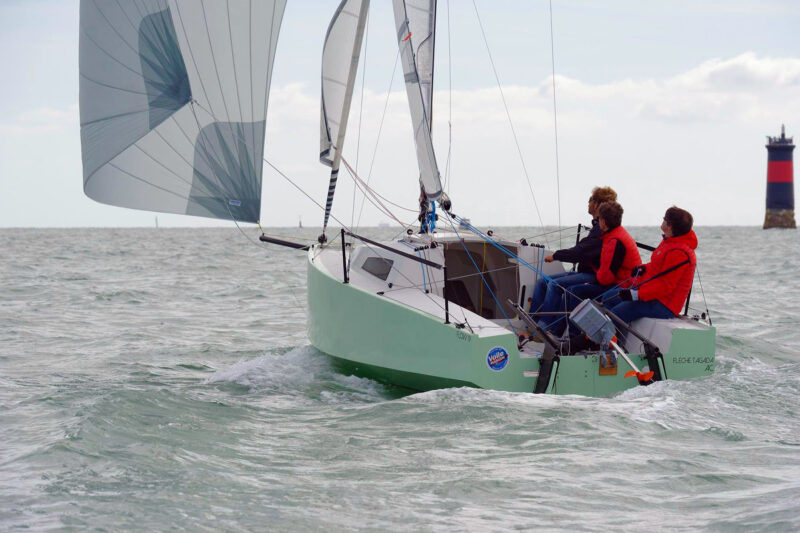
Off the wind, the Flow 19 can set a variety of headsails. An asymmetric spinnaker, set on a retractable bowsprit provides a good deal of power and introduces an extra element of fun downwind.
The Flow 19 loves light air, and with as little as 5 knots the boat will start gliding elegantly at 2 or 3 knots. As the wind picks up to 10 to 12 knots, closehauled, it will point at 45° to 50° off the wind and find comfort heeled on its hard chines. Depending on the sea state, the boat’s speed is in the 4- to 6-knot range. Once the wind speed reaches 12 knots, it’s time to consider taking a reef; the main has two reefpoints, which provide enough sail reduction up to 20 knots of wind. (I should note here that in harsh conditions, the boat will sail much better under main-only rather than solely on the jib.) I have sailed solo, beating into winds over 20 knots with two reefs and just using the main, and felt that the boat was still manageable. However, as in most sailboats, sailing off the wind on a beam or broad reach will bring more comfort to the crew and will unveil the full abilities of the planing hull. Without the kite up, we had beautiful and long stretches of 7 to 8 knots downwind. With an extra sail on the bowsprit, reaching 10 knots should be easy. Antoine said he has pushed the boat up to 12 knots with an asymmetrical spinnaker.
In its first season, we took our Flow 19 through diverse sailing grounds, from the warm waters of Florida to the northern lakes of Maine. Our typical trips are two to three days long. This capable coastal cruiser is a good mix of comfort and performance for a boat of that size. It surely feels bigger than the 19′ length, and the high freeboard and voluminous hull provide a safe and joyful ride on the water.![]()
Thierry Humeau was raised in France and started sailing at age eight on Optimist and 420 dinghies. In his teenage years, he joined his hometown kayak club and became a successful competitor in whitewater slalom, culminating with participation in the 1992 Olympics canoeing event in Barcelona. He later moved to the U.S. and worked as a cameraman for a variety of television programs. He returned to sailing in 2012 and enjoys family cruising on Chesapeake Bay.
Flow 19 Particulars
LOA: 19′
Beam: 7′ 6 1⁄2″
Draft: 4″ (swing keel up); 4′ 3 1⁄4″ (swing keel down)
Weight (water-ballast tanks full): 1,146 lbs
Towing weight (tanks empty): 992 lbs
Ballast (weighted keel + water): 418 lbs
Sail area: 243 sq ft
Main: 151 sq ft
Genoa: 91 sq ft
Cabin headroom: 4′ 3″
The Flow 19 is made in France by Prodesign3D and has a base price of $59,000. It is also available as a kit or a decked hull.
Is there a boat you’d like to know more about? Have you built one that you think other Small Boats readers would enjoy? Please email us.
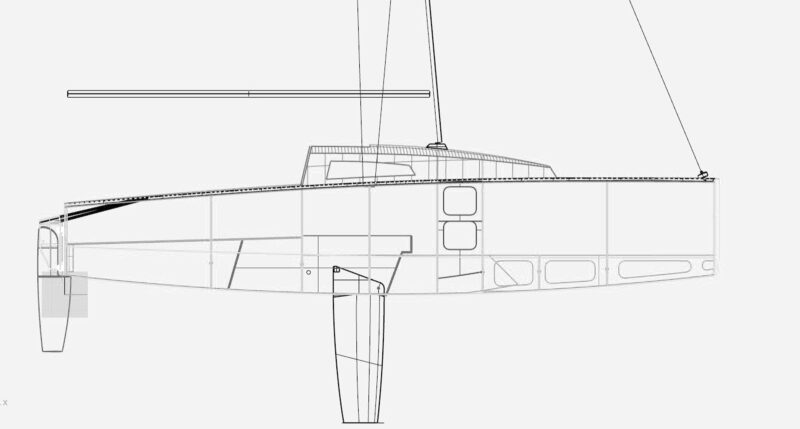
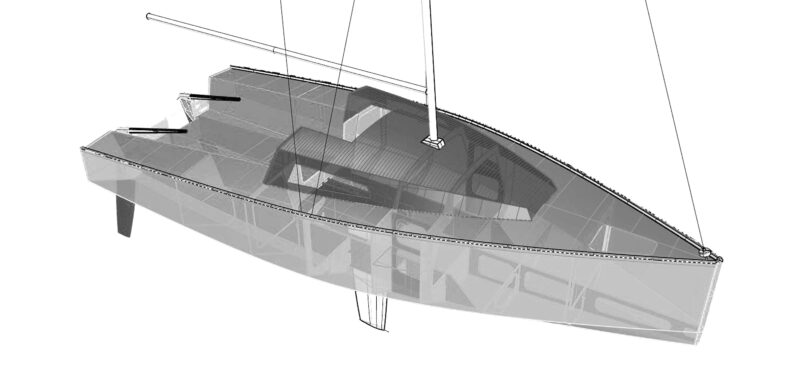
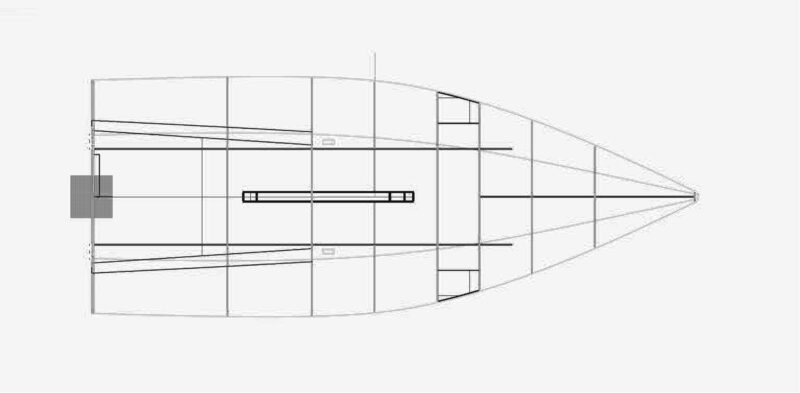
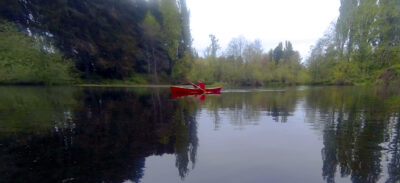

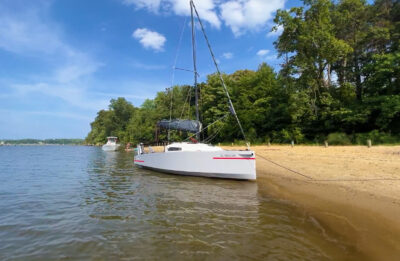
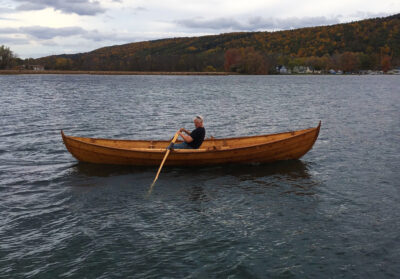
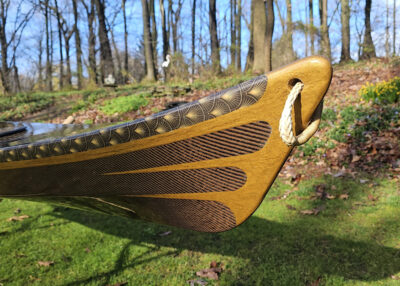
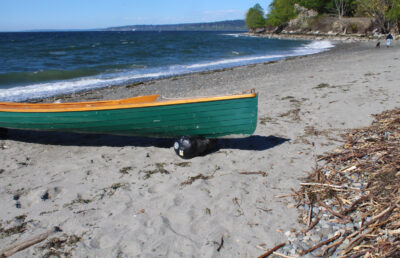
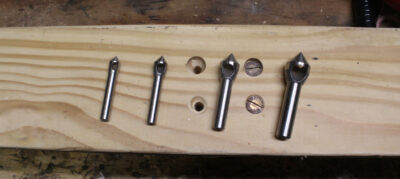
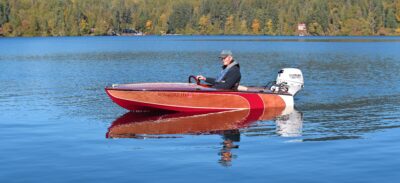
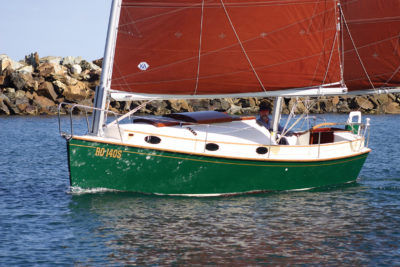
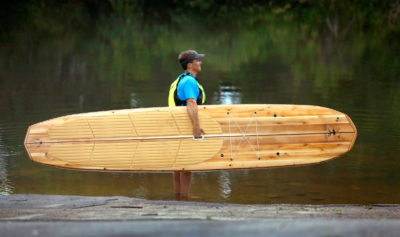
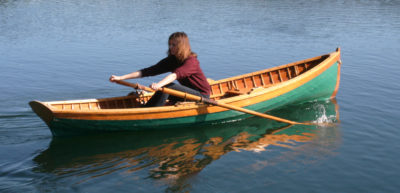
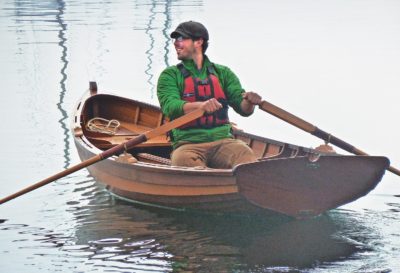
This ticks a lot of my boxes in a trailer sailor. Curious if the rather flat bottom and relatively light weight make a rougher ride in 2′ wind waves.
The boat has a high, narrow and voluminous bow which helps cut well through the chop, even when going upwind at 20 knots. The bottom is indeed flat but narrow from the bow for the first 6′ or 7′. A scow type hull with a large rounded bow is more prone to slamming in the waves.
I see the spirit of the Corsair in this boat. Awesome.
Fiche technique du Corsaire
Matériau : CP ou polyester (Originally plywood)
Chantiers : Morin, Meulan, Naviking etc…
Architecte : Jean-Jacques Herbulot
Longueur coque : 5,50 m
Longueur flottaison : 4,92 m
Largeur : 1,92 m
Tirant d’eau : 0,55/1,00 m
Tirant d’eau JOG : 1,10 m
Poids lège : 560 kg
Lest : 150 kg
Surface de voile : 18,30 m2
Surface de voile JOG : 16,00 m2
Moteur : hors-bord 2 à 4 ch, parfois sans
Good guess! Antoine, the architect of the Flow 19 and owner of Atelier Interface had a renovated Corsair in the factory backyard when I ordered the boat.
Hello Thierry,
Great article and I really enjoy your You Tube videos and recommend them to the other readers.
Very cool new boat. It appears as if the designers borrowed from the 6.5-meter mini-transat boats, without the keel of course.
As we all know, it’s great going 55 knots upwind on our local highway.
Thanks Bill,
Yes, the Flow 19 has been inspired by 6.50 Minis, Seascape (now Beneteau First) planing hulls designed by Sam Manard and also as a reader mentioned above some classic French wood/epoxy designs such as the Corsair and Muscadet.